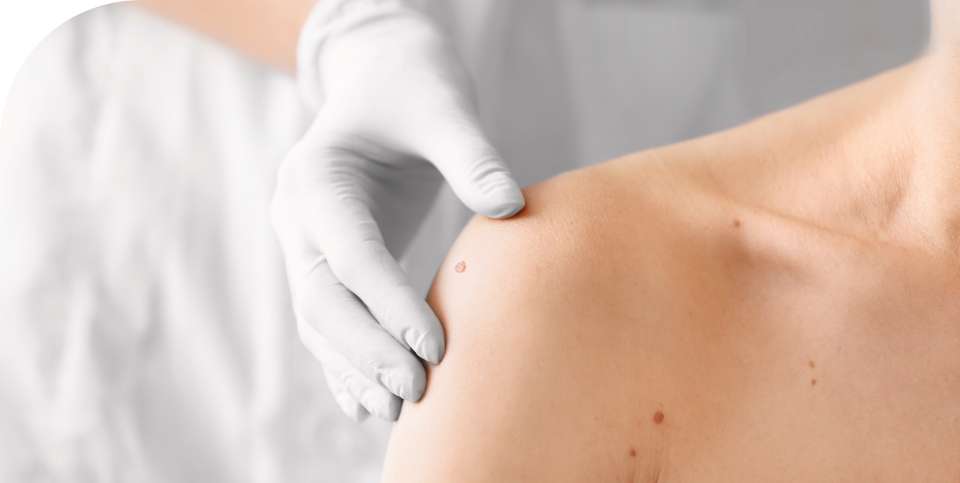Skin cancer, which is the most common form of cancer in the United States, is the result of the abnormal growth of skin cells. Cancer can affect skin anywhere on the body, but most frequently appears on skin that is exposed to the sun. There are more than a million new cases of skin cancer in the United States each year.
TYPES OF SKIN CANCER
There are three major types of skin cancer, and they affect different layers of the skin. They are named for the different types of skin cells that become cancerous.
Basal Cell Carcinoma
Basal cell skin cancer occurs in the basal cell layer of the skin and is the most common type of skin cancer in people with fair skin. It commonly occurs on areas of the skin that have been exposed to the sun, such as the face. It rarely spreads to other parts of the body.
Five Warning Signs of Basal Cell Carcinoma
An open sore that bleeds, oozes, or crusts and remains open for a few weeks, only to heal up and then bleed again. A persistent, non–healing sore is a very common sign of an early BCC.
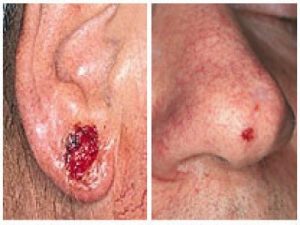
A reddish patch or irritated area, frequently occurring on the face, chest, shoulders, arms, or legs. Sometimes the patch crusts. It may also itch or hurt. At other times, it persists with no discomfort.
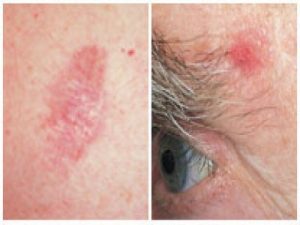
A shiny bump or nodule that is pearly or clear and is often pink, red, or white. The bump can also be tan, black, or brown, especially in dark-haired people, and can be confused with a normal mole.
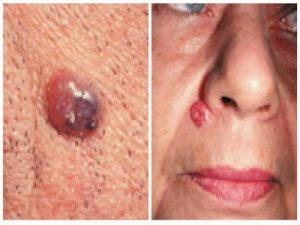
A pink growth with a slightly elevated rolled border and a crusted indentation in the center. As the growth slowly enlarges, tiny blood vessels may develop on the surface.
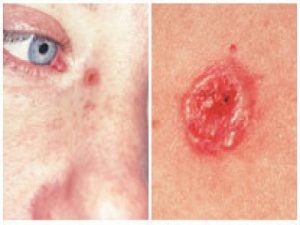
A scar-like area that is white, yellow or waxy, and often has poorly defined borders; the skin itself appears shiny and taut. This warning sign may indicate the presence of an invasive BCC that is larger than it appears to be on the surface.
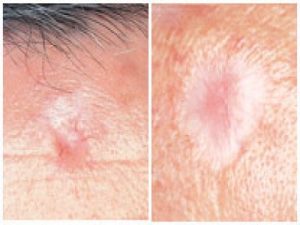
Squamous Cell Carcinoma
Squamous cell carcinoma occurs in the squamous cells, and is the most common type of skin cancer in people with dark skin, who typically get it in places, such as the legs or feet, that have not been exposed to the sun. In people with fair skin, it usually occurs in sun-exposed areas such as on the face, head, ears and neck. Squamous cell skin cancer can spread to other parts of the body.
Four Warning Signs of Squamous Cell Carcinoma
A persistent, scaly red patch with irregular borders that sometimes crusts or bleeds.
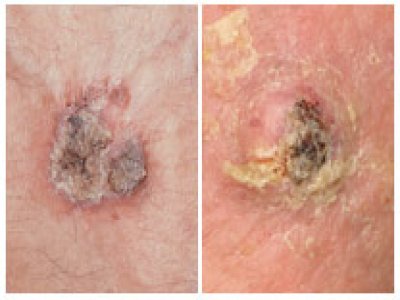
An elevated growth with a central depression that occasionally bleeds. A growth of this type may rapidly increase in size.
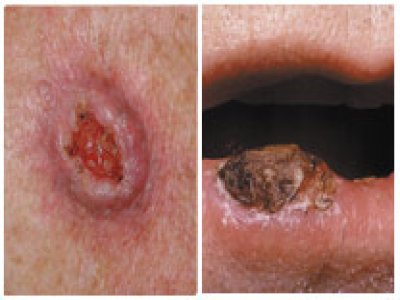
An open sore that bleeds and crusts and persists for weeks.
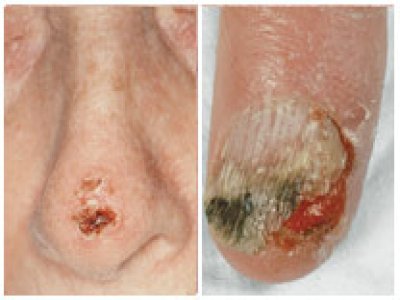
A wart-like growth that crusts and occasionally bleeds.
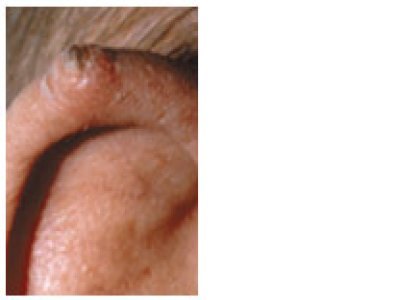
Melanoma
Melanoma is the most aggressive type of cancer, and the most likely to spread to other parts of the body. Melanoma occurs in the melanocyte (pigment) cells of the skin, and can form on any part of the body, regardless of past sun exposure.
A B C D E’s of Melanoma
A) Asymmetry
This benign mole is not asymmetrical. If you draw a line through the middle, the two sides will match, meaning it is symmetrical. If you draw a line through this mole, the two halves will not match, meaning it is asymmetrical, a warning sign for melanoma.
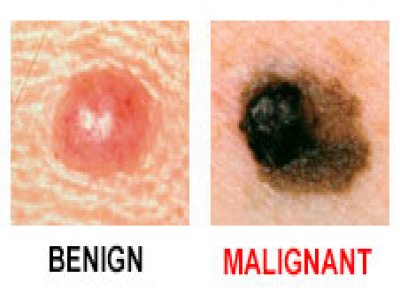
B) Border
A benign mole has smooth, even borders, unlike melanomas. The borders of an early melanoma tend to be uneven. The edges may be scalloped or notched.
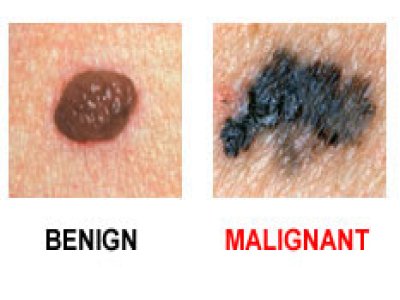
C) Color
Most benign moles are all one color — often a single shade of brown. Having a variety of colors is another warning signal. A number of different shades of brown, tan or black could appear. A melanoma may also become red, white or blue.
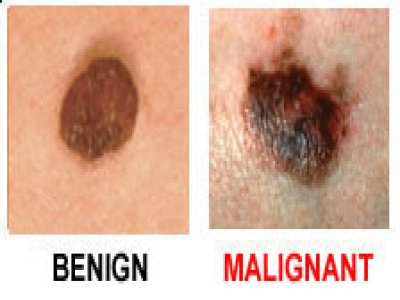
D) Diameter
Benign moles usually have a smaller diameter than malignant ones. Melanomas usually are larger in diameter than the eraser on your pencil tip (¼ inch or 6mm), but they may sometimes be smaller when first detected.
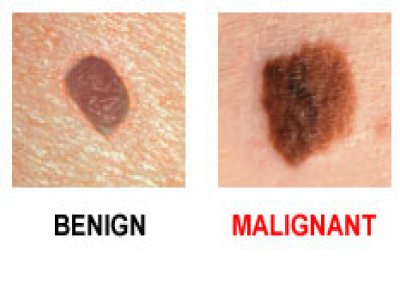
E) Evolving
Common, benign moles look the same over time. Be on the alert when a mole starts to evolve or change in any way. When a mole is evolving, see a doctor. Any change — in size, shape, color, elevation, or another trait, or any new symptom such as bleeding, itching or crusting — points to danger.
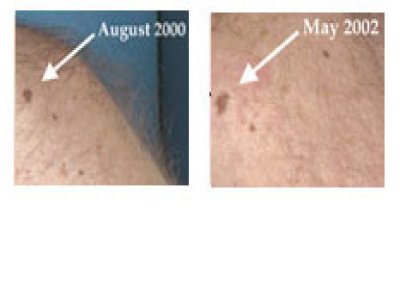
SYMPTOMS OF SKIN CANCER
Skin cancer is often identified as a new or changed growth on the skin of the scalp, face, lips, ears, neck, chest, arms, hands or legs. Although these are common areas for skin-cancer growths to form, they can occur anywhere, and manifest themselves as the following:
- Pearly or waxy bump
- Flesh-colored or brown scar-like lesion
- Firm, red nodule
- Crusted, flat lesion
- Large brown spot with darker speckles
- Shiny, firm bumps
A mole that changes shape or color can also indicate skin cancer.
DIAGNOSIS OF SKIN CANCER
To diagnose skin cancer, a doctor reviews all symptoms, and checks the skin for any unusual growths or abnormal patches of skin. If skin cancer is suspected, a biopsy is performed on the growth or area of skin in question. Once the results of the biopsy are reviewed, the type of cancer can be determined, and a treatment plan created. Those who experience any skin changes, or have changes to existing moles or birthmarks, should see a doctor as soon as possible; early detection is key in successfully treating skin cancer.
TREATMENT FOR SKIN CANCER
Treatment for skin cancer depends on the type, size and location of the tumor. Most options include the removal of the entire growth, and are effective forms of treatment. Removal procedures are usually simple, requiring only a local anesthetic in an outpatient setting. Some of the treatment options for skin cancer include the following:
- Freezing
- Excision
- Laser therapy
- Mohs surgery
Depending on the stage and severity of the skin cancer, in addition to removal of the growth, chemotherapy and radiation may be recommended.

